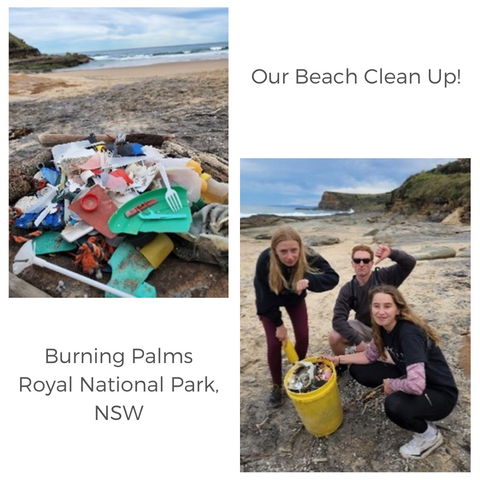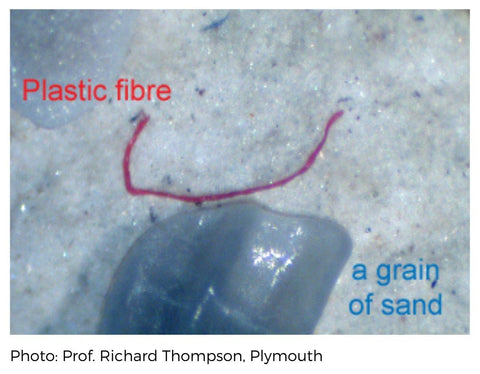My Shopping Cart
Your cart is currently empty.
Continue ShoppingIn recent decades, synthetic textiles have become part of everyday life, woven into the fabrics of modern fashion and homewares. From polyester to nylon, these man-made fibres are durable, versatile, and affordable. However, beneath their seemingly innocuous surface lies a complex web of environmental and health concerns that demand our attention.
The issues surrounding synthetic textiles are multi-faceted; from their reliance on fossil fuels and subsequent impact on climate change to the unseen threat of micro plastic pollution, their full impact on ourselves, other living organisms and the planet have yet to be understood.
Fossil Fuels and Synthetic Textile Production
One of the primary concerns associated with synthetic textiles is their heavy reliance on fossil fuels in their production process. Most synthetic fibres, such as polyester, nylon, and acrylic, are derived from petrochemicals – the same non-renewable raw materials used to produce plastics. The extraction, refinement, and processing of these fossil fuels generate significant carbon emissions, contributing to climate change and environmental degradation.
The production of synthetic textiles involves energy-intensive processes, including polymerization, spinning, weaving, and finishing to create what is essentially plastic fibres. These processes not only consume vast amounts of energy but also release harmful pollutants into the air and waterways.
Synthetic Textiles: Plastic in Disguise
Despite their fabric like appearance, synthetic textiles are essentially plastic fibres woven together to create materials from which we make clothes and homewares.
The prevalence of synthetic textiles in the fashion and homeware industries has led to a massive plastic pollution problem. Every time synthetic products are shaken, aired or washed; millions of tiny plastic particles are shed into the environment. These micro plastics are so small that they easily bypass wastewater treatment systems and end up contaminating rivers, lakes, and oceans. Once in the marine environment, these tiny particles of plastic pose a serious threat to marine life, as they’re ingested by fish and other aquatic organisms. And if you enjoy eating seafood, they end up in you too. (Do the clothes you wear end up in the food you eat Read more.... )
Microfibre Pollution: An Invisible Threat


While the visible impacts of plastic pollution – such as plastic bags, bottles, straws and fishing nets littering our beaches are well-documented, and we’ve made huge progress thanks to legislation in Australia reducing the use of single use plastic shopping bags, the issue of microfibre pollution remains both pervasive and largely invisible to the naked eye. Microfibers, tiny particles of plastic measuring less than 5 millimetres in length, are released from synthetic textiles during use and continue to break off once the item is discarded. These tiny fibres are too small to be captured by conventional filtration systems and can easily penetrate water treatment plants, ultimately entering our waterways and oceans.

The sources of micro plastic pollution
It is estimated that synthetic textiles are responsible for between 200,000 and 500,000 tonnes of microplastics into the ocean every year. (Ellen MacArthur Foundation, 2017) This is the equivalent of 50 billion plastic bottles.
***and over 700,000 plastic fibres are shed when you wash an average 6kg load of acrylic clothes or homewares*** (Read research paper)
Once in the marine environment, microfibers act as magnets for harmful chemicals and pollutants, such as pesticides and industrial chemicals, which adhere to their surface. As these contaminated micro plastics are ingested by marine life, they can accumulate in the tissues of fish and other organisms, posing risks to ecosystem health and human well-being.
In the air that we breathe
Recent studies have highlighted the airborne transmission of micro plastics. Synthetic textiles release micro plastics into the atmosphere during everyday activities. Shaking out your microfibre doona for example releases airborne micro plastics into the air that you breathe. They don’t stop there! These tiny plastic fibres can travel long distances from inland urban areas to settle in distant ecosystems, contributing to environmental contamination on a global scale. Plastic fibres have found their way to remote islands, polar regions and have even been discovered in clouds above mountains! But their real impact on the weather from their presence in clouds has yet to be fully understood. Like much of the impact of these plastic fibres, understanding their true impact is yet to happen.
Assessing the health implications of synthetic textiles
Micro plastics have been found in various food sources, including seafood, salt and even drinking water, raising concerns about their potential health effects.
The average adult consumes approximately 2000 microplastics per year through salt alone, according to a recent study. (UNDP)
The long-term consequences of this are yet to be understood, but evidence to date suggests that micro plastics may have adverse effects on systems in the human body, including the digestive, respiratory, endocrine, reproductive and immune systems.
It’s got to STOP
Annual production of plastic fibre worldwide is increasing; we’ve reached 60 billion kgs. This is not sustainable. It is now up to industry to seek out alternatives, that at the end of life can break down and return to the earth without leaving a trail of toxins behind.
By embracing more sustainable practices, together we can work towards a future where textiles in fashion and the home are not only stylish and functional but also environmentally responsible. From choosing natural and biodegradable fibres, each of us, through our choices, has the power to make a positive difference in shaping the future and protecting the planet for generations to come.